Sheffield University Native Speaker Perception of American English
VerifiedAdded on 2023/06/14
|22
|5291
|300
Thesis and Dissertation
AI Summary
This thesis investigates native English speakers' perceptions of English as a global language, focusing on students at Sheffield University. It explores their attitudes towards variations in English, particularly American English, and how these perceptions influence their acceptance of English as a lingua franca. The study examines the impact of global communication, technology, and the international environment on shaping English as an International Language (EIL). It also delves into factors contributing to students' attitudes towards world Englishes, including cultural affiliations and the role of English in professional development. The research employs surveys, interviews, and focus group discussions to gather data and analyze the psychosocial and linguistic challenges faced by native English speakers in a globalized world, considering issues of identity, language modeling, and regional language preferences.
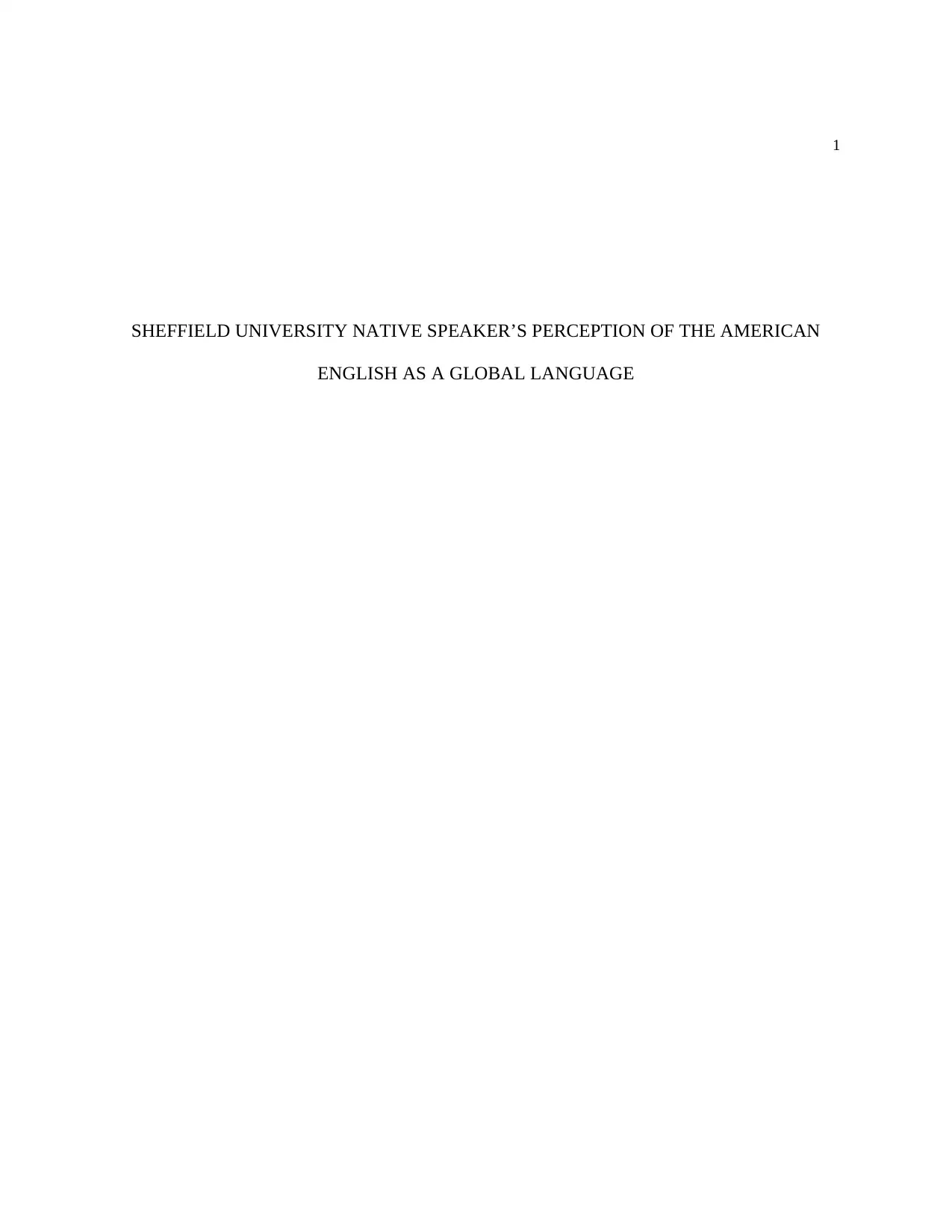
1
SHEFFIELD UNIVERSITY NATIVE SPEAKER’S PERCEPTION OF THE AMERICAN
ENGLISH AS A GLOBAL LANGUAGE
SHEFFIELD UNIVERSITY NATIVE SPEAKER’S PERCEPTION OF THE AMERICAN
ENGLISH AS A GLOBAL LANGUAGE
Paraphrase This Document
Need a fresh take? Get an instant paraphrase of this document with our AI Paraphraser
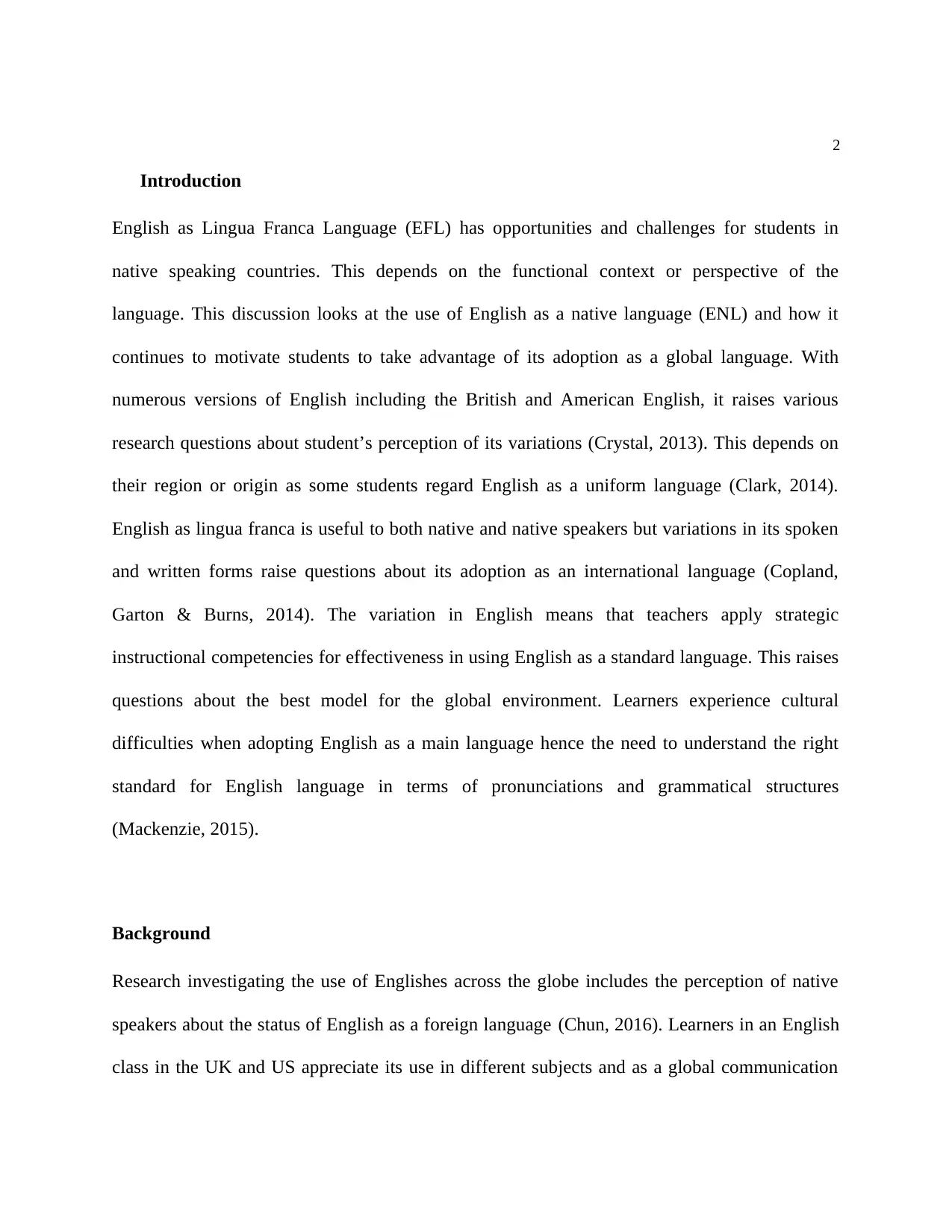
2
Introduction
English as Lingua Franca Language (EFL) has opportunities and challenges for students in
native speaking countries. This depends on the functional context or perspective of the
language. This discussion looks at the use of English as a native language (ENL) and how it
continues to motivate students to take advantage of its adoption as a global language. With
numerous versions of English including the British and American English, it raises various
research questions about student’s perception of its variations (Crystal, 2013). This depends on
their region or origin as some students regard English as a uniform language (Clark, 2014).
English as lingua franca is useful to both native and native speakers but variations in its spoken
and written forms raise questions about its adoption as an international language (Copland,
Garton & Burns, 2014). The variation in English means that teachers apply strategic
instructional competencies for effectiveness in using English as a standard language. This raises
questions about the best model for the global environment. Learners experience cultural
difficulties when adopting English as a main language hence the need to understand the right
standard for English language in terms of pronunciations and grammatical structures
(Mackenzie, 2015).
Background
Research investigating the use of Englishes across the globe includes the perception of native
speakers about the status of English as a foreign language (Chun, 2016). Learners in an English
class in the UK and US appreciate its use in different subjects and as a global communication
Introduction
English as Lingua Franca Language (EFL) has opportunities and challenges for students in
native speaking countries. This depends on the functional context or perspective of the
language. This discussion looks at the use of English as a native language (ENL) and how it
continues to motivate students to take advantage of its adoption as a global language. With
numerous versions of English including the British and American English, it raises various
research questions about student’s perception of its variations (Crystal, 2013). This depends on
their region or origin as some students regard English as a uniform language (Clark, 2014).
English as lingua franca is useful to both native and native speakers but variations in its spoken
and written forms raise questions about its adoption as an international language (Copland,
Garton & Burns, 2014). The variation in English means that teachers apply strategic
instructional competencies for effectiveness in using English as a standard language. This raises
questions about the best model for the global environment. Learners experience cultural
difficulties when adopting English as a main language hence the need to understand the right
standard for English language in terms of pronunciations and grammatical structures
(Mackenzie, 2015).
Background
Research investigating the use of Englishes across the globe includes the perception of native
speakers about the status of English as a foreign language (Chun, 2016). Learners in an English
class in the UK and US appreciate its use in different subjects and as a global communication

3
tool. As a result, researchers continue to study ENL and how it shapes learners identity. Norton
(2013) presents an article on the sociological aspect of language to note that the geographical
spread of English in the international environment affects social interaction and presents
opportunities for polished speakers. However, English standards vary raising concerns about
student’s mastery, competency, beliefs and identity. Language functions include communication
and professional development. Globalization presents challenges and opportunities for students
in English native lands. This includes the social influences of English as a core subject in
international studies including its ideologies and its evolution in a multicultural environment
(Kirkpatrick, World Englishes, 2014) This explains why ENS strives to attain competencies in
English for opportunities in the global community. Its economic benefits may also become a
challenge due to the geographical variations of English as a global language (Neeley, 2013).
This study focuses on the native students from Sheffield and their perception of English, its use
as an emerging language and the existing psychosocial and linguistic challenges.
Purpose of the study
The study seeks to collect data from a survey in order to understand the native speaker’s
perception of Englishes. Jones, Baxter and Khadija (2013) support this research because it
yields meaningful results for global language studies. This study is an addition to quantitative
and qualitative study of English as a global language (Kirkpatrick, World Englishes, 2014). The
target population is a group of English native students at the college level. It features an
experiment on the perception of proficient students on native English standards, cultural
affiliation and reasons for using English for professional development. The study also explores
areas in which English standards are dominant such as in technology and how this shapes its
tool. As a result, researchers continue to study ENL and how it shapes learners identity. Norton
(2013) presents an article on the sociological aspect of language to note that the geographical
spread of English in the international environment affects social interaction and presents
opportunities for polished speakers. However, English standards vary raising concerns about
student’s mastery, competency, beliefs and identity. Language functions include communication
and professional development. Globalization presents challenges and opportunities for students
in English native lands. This includes the social influences of English as a core subject in
international studies including its ideologies and its evolution in a multicultural environment
(Kirkpatrick, World Englishes, 2014) This explains why ENS strives to attain competencies in
English for opportunities in the global community. Its economic benefits may also become a
challenge due to the geographical variations of English as a global language (Neeley, 2013).
This study focuses on the native students from Sheffield and their perception of English, its use
as an emerging language and the existing psychosocial and linguistic challenges.
Purpose of the study
The study seeks to collect data from a survey in order to understand the native speaker’s
perception of Englishes. Jones, Baxter and Khadija (2013) support this research because it
yields meaningful results for global language studies. This study is an addition to quantitative
and qualitative study of English as a global language (Kirkpatrick, World Englishes, 2014). The
target population is a group of English native students at the college level. It features an
experiment on the perception of proficient students on native English standards, cultural
affiliation and reasons for using English for professional development. The study also explores
areas in which English standards are dominant such as in technology and how this shapes its
⊘ This is a preview!⊘
Do you want full access?
Subscribe today to unlock all pages.

Trusted by 1+ million students worldwide

4
adoption as ELF. It highlights the role of teachers in developing language competencies in the
global environment. Language practices in the contemporary society also emerge with social
media and technology communication emerging as a new area for research in EIL. This study
explains why variations in the UK and US Standard English affects its application in the
corporate world creating challenges on the most popular version for use in the business world.
Research Questions
This discussion aligns the English language with the global contexts and learners perception. It
answers the following question:
What perception do native learners in college have of English and its variations?
How does this perception influence their acceptance of English as a global language?
What effect does global communication have on native students?
What is the role of technology and the international environment in shaping EIL?
What factors contribute to the students' attitude of world Englishes?
Theoretical Background
Crystal (2012) considers English as a global language based on its history, current
developments and future expectations. This explains the student’s perception of the language as
an international language. Critical issues emerging include its commercial role and cultural
perspective (Neeley, 2012: Smith, 2015:Fisher, 2015).
adoption as ELF. It highlights the role of teachers in developing language competencies in the
global environment. Language practices in the contemporary society also emerge with social
media and technology communication emerging as a new area for research in EIL. This study
explains why variations in the UK and US Standard English affects its application in the
corporate world creating challenges on the most popular version for use in the business world.
Research Questions
This discussion aligns the English language with the global contexts and learners perception. It
answers the following question:
What perception do native learners in college have of English and its variations?
How does this perception influence their acceptance of English as a global language?
What effect does global communication have on native students?
What is the role of technology and the international environment in shaping EIL?
What factors contribute to the students' attitude of world Englishes?
Theoretical Background
Crystal (2012) considers English as a global language based on its history, current
developments and future expectations. This explains the student’s perception of the language as
an international language. Critical issues emerging include its commercial role and cultural
perspective (Neeley, 2012: Smith, 2015:Fisher, 2015).
Paraphrase This Document
Need a fresh take? Get an instant paraphrase of this document with our AI Paraphraser
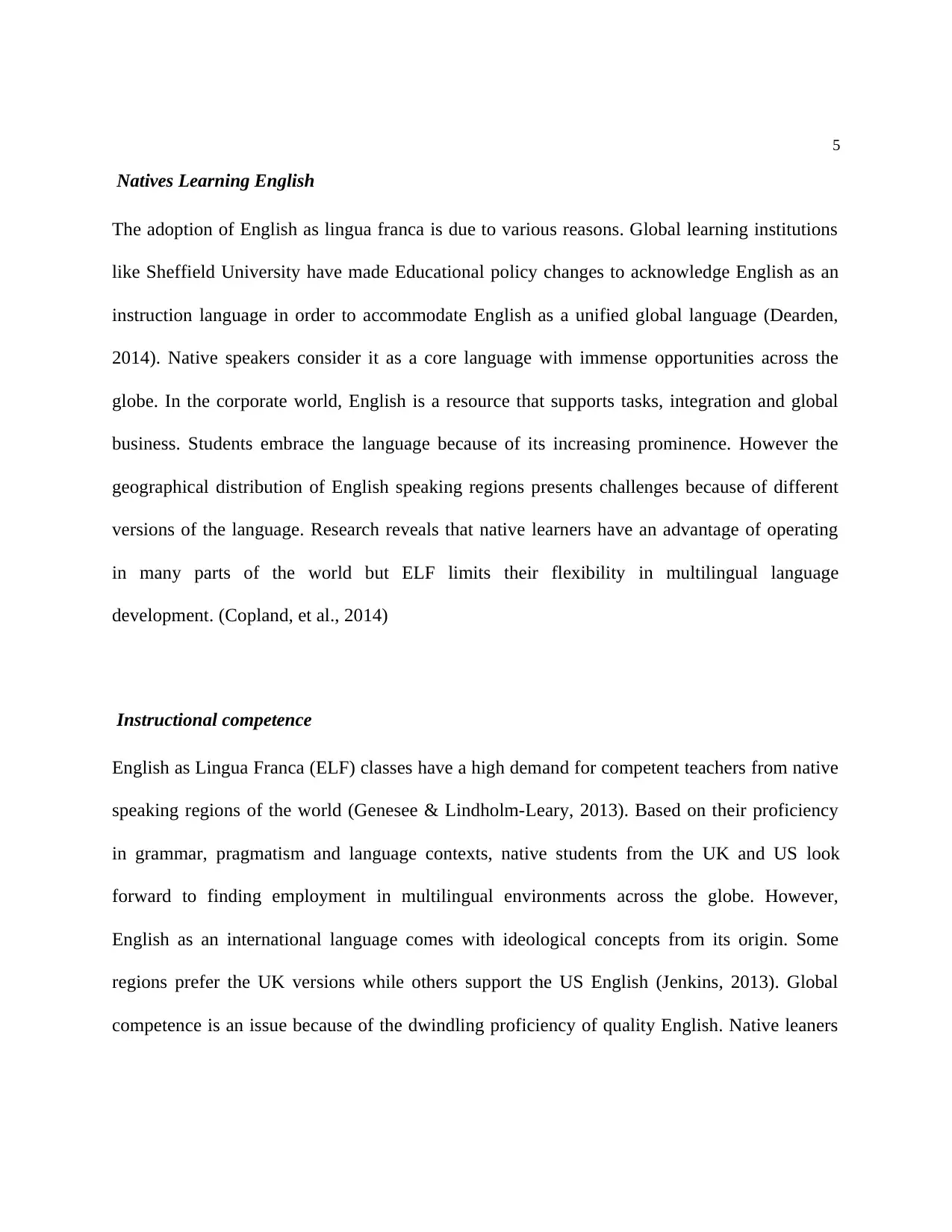
5
Natives Learning English
The adoption of English as lingua franca is due to various reasons. Global learning institutions
like Sheffield University have made Educational policy changes to acknowledge English as an
instruction language in order to accommodate English as a unified global language (Dearden,
2014). Native speakers consider it as a core language with immense opportunities across the
globe. In the corporate world, English is a resource that supports tasks, integration and global
business. Students embrace the language because of its increasing prominence. However the
geographical distribution of English speaking regions presents challenges because of different
versions of the language. Research reveals that native learners have an advantage of operating
in many parts of the world but ELF limits their flexibility in multilingual language
development. (Copland, et al., 2014)
Instructional competence
English as Lingua Franca (ELF) classes have a high demand for competent teachers from native
speaking regions of the world (Genesee & Lindholm-Leary, 2013). Based on their proficiency
in grammar, pragmatism and language contexts, native students from the UK and US look
forward to finding employment in multilingual environments across the globe. However,
English as an international language comes with ideological concepts from its origin. Some
regions prefer the UK versions while others support the US English (Jenkins, 2013). Global
competence is an issue because of the dwindling proficiency of quality English. Native leaners
Natives Learning English
The adoption of English as lingua franca is due to various reasons. Global learning institutions
like Sheffield University have made Educational policy changes to acknowledge English as an
instruction language in order to accommodate English as a unified global language (Dearden,
2014). Native speakers consider it as a core language with immense opportunities across the
globe. In the corporate world, English is a resource that supports tasks, integration and global
business. Students embrace the language because of its increasing prominence. However the
geographical distribution of English speaking regions presents challenges because of different
versions of the language. Research reveals that native learners have an advantage of operating
in many parts of the world but ELF limits their flexibility in multilingual language
development. (Copland, et al., 2014)
Instructional competence
English as Lingua Franca (ELF) classes have a high demand for competent teachers from native
speaking regions of the world (Genesee & Lindholm-Leary, 2013). Based on their proficiency
in grammar, pragmatism and language contexts, native students from the UK and US look
forward to finding employment in multilingual environments across the globe. However,
English as an international language comes with ideological concepts from its origin. Some
regions prefer the UK versions while others support the US English (Jenkins, 2013). Global
competence is an issue because of the dwindling proficiency of quality English. Native leaners
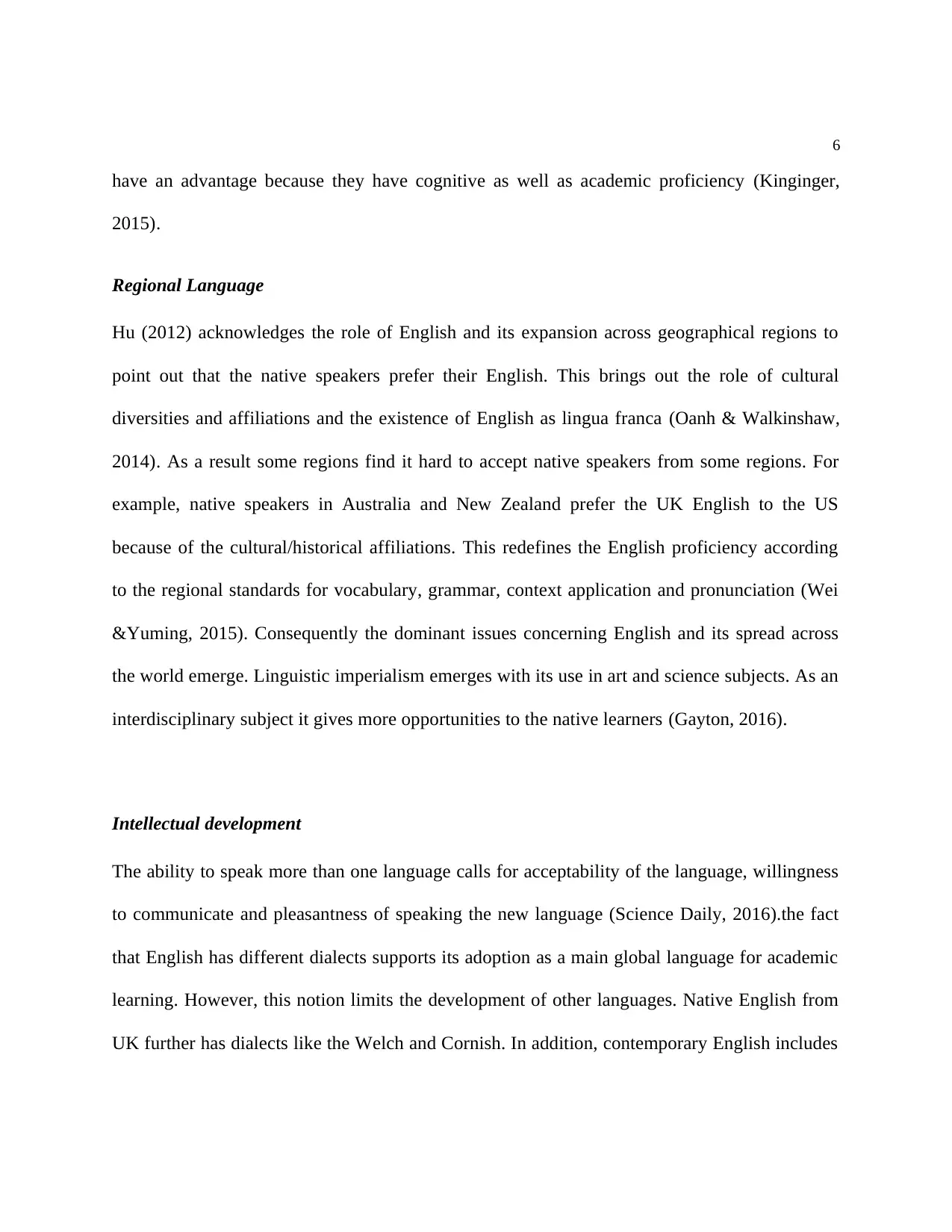
6
have an advantage because they have cognitive as well as academic proficiency (Kinginger,
2015).
Regional Language
Hu (2012) acknowledges the role of English and its expansion across geographical regions to
point out that the native speakers prefer their English. This brings out the role of cultural
diversities and affiliations and the existence of English as lingua franca (Oanh & Walkinshaw,
2014). As a result some regions find it hard to accept native speakers from some regions. For
example, native speakers in Australia and New Zealand prefer the UK English to the US
because of the cultural/historical affiliations. This redefines the English proficiency according
to the regional standards for vocabulary, grammar, context application and pronunciation (Wei
&Yuming, 2015). Consequently the dominant issues concerning English and its spread across
the world emerge. Linguistic imperialism emerges with its use in art and science subjects. As an
interdisciplinary subject it gives more opportunities to the native learners (Gayton, 2016).
Intellectual development
The ability to speak more than one language calls for acceptability of the language, willingness
to communicate and pleasantness of speaking the new language (Science Daily, 2016).the fact
that English has different dialects supports its adoption as a main global language for academic
learning. However, this notion limits the development of other languages. Native English from
UK further has dialects like the Welch and Cornish. In addition, contemporary English includes
have an advantage because they have cognitive as well as academic proficiency (Kinginger,
2015).
Regional Language
Hu (2012) acknowledges the role of English and its expansion across geographical regions to
point out that the native speakers prefer their English. This brings out the role of cultural
diversities and affiliations and the existence of English as lingua franca (Oanh & Walkinshaw,
2014). As a result some regions find it hard to accept native speakers from some regions. For
example, native speakers in Australia and New Zealand prefer the UK English to the US
because of the cultural/historical affiliations. This redefines the English proficiency according
to the regional standards for vocabulary, grammar, context application and pronunciation (Wei
&Yuming, 2015). Consequently the dominant issues concerning English and its spread across
the world emerge. Linguistic imperialism emerges with its use in art and science subjects. As an
interdisciplinary subject it gives more opportunities to the native learners (Gayton, 2016).
Intellectual development
The ability to speak more than one language calls for acceptability of the language, willingness
to communicate and pleasantness of speaking the new language (Science Daily, 2016).the fact
that English has different dialects supports its adoption as a main global language for academic
learning. However, this notion limits the development of other languages. Native English from
UK further has dialects like the Welch and Cornish. In addition, contemporary English includes
⊘ This is a preview!⊘
Do you want full access?
Subscribe today to unlock all pages.

Trusted by 1+ million students worldwide
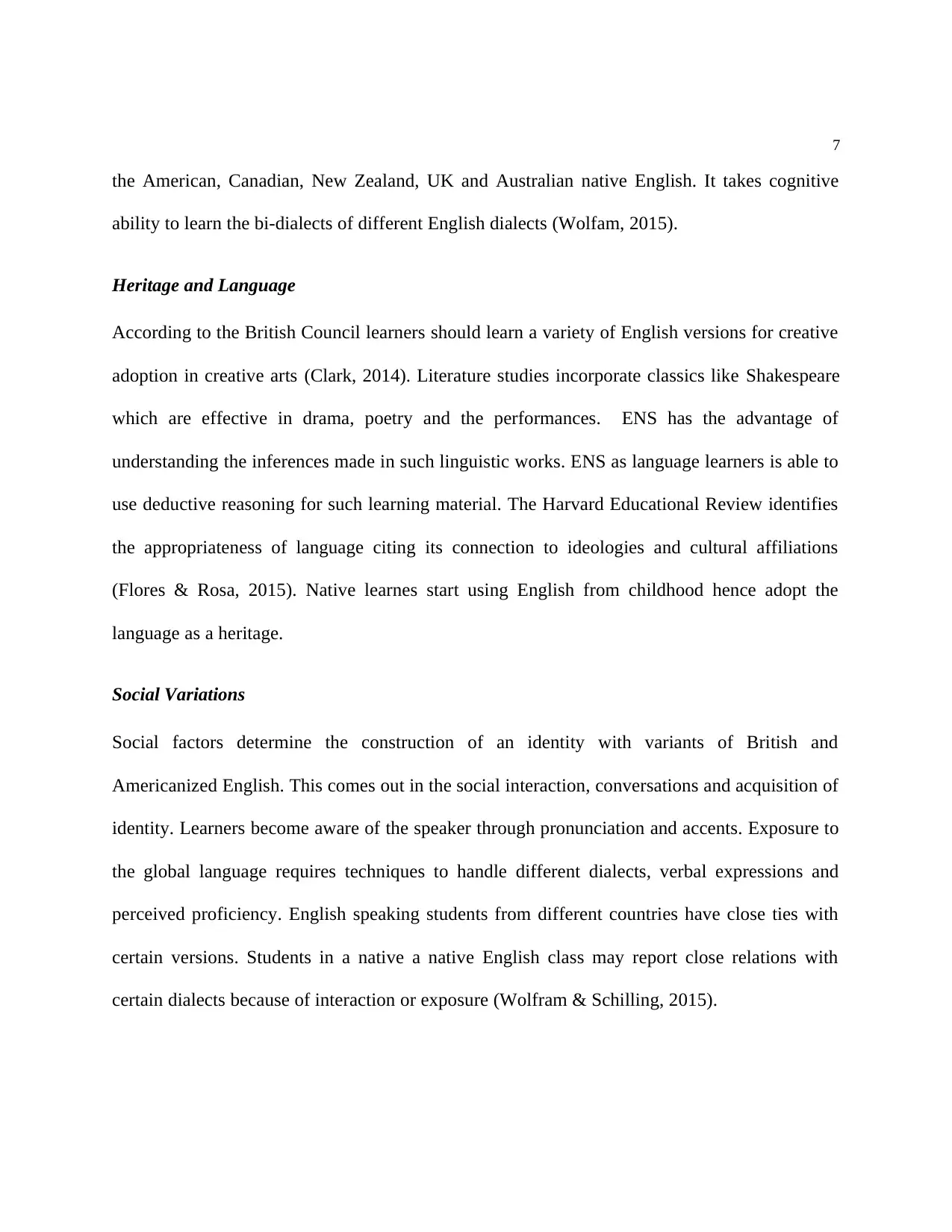
7
the American, Canadian, New Zealand, UK and Australian native English. It takes cognitive
ability to learn the bi-dialects of different English dialects (Wolfam, 2015).
Heritage and Language
According to the British Council learners should learn a variety of English versions for creative
adoption in creative arts (Clark, 2014). Literature studies incorporate classics like Shakespeare
which are effective in drama, poetry and the performances. ENS has the advantage of
understanding the inferences made in such linguistic works. ENS as language learners is able to
use deductive reasoning for such learning material. The Harvard Educational Review identifies
the appropriateness of language citing its connection to ideologies and cultural affiliations
(Flores & Rosa, 2015). Native learnes start using English from childhood hence adopt the
language as a heritage.
Social Variations
Social factors determine the construction of an identity with variants of British and
Americanized English. This comes out in the social interaction, conversations and acquisition of
identity. Learners become aware of the speaker through pronunciation and accents. Exposure to
the global language requires techniques to handle different dialects, verbal expressions and
perceived proficiency. English speaking students from different countries have close ties with
certain versions. Students in a native a native English class may report close relations with
certain dialects because of interaction or exposure (Wolfram & Schilling, 2015).
the American, Canadian, New Zealand, UK and Australian native English. It takes cognitive
ability to learn the bi-dialects of different English dialects (Wolfam, 2015).
Heritage and Language
According to the British Council learners should learn a variety of English versions for creative
adoption in creative arts (Clark, 2014). Literature studies incorporate classics like Shakespeare
which are effective in drama, poetry and the performances. ENS has the advantage of
understanding the inferences made in such linguistic works. ENS as language learners is able to
use deductive reasoning for such learning material. The Harvard Educational Review identifies
the appropriateness of language citing its connection to ideologies and cultural affiliations
(Flores & Rosa, 2015). Native learnes start using English from childhood hence adopt the
language as a heritage.
Social Variations
Social factors determine the construction of an identity with variants of British and
Americanized English. This comes out in the social interaction, conversations and acquisition of
identity. Learners become aware of the speaker through pronunciation and accents. Exposure to
the global language requires techniques to handle different dialects, verbal expressions and
perceived proficiency. English speaking students from different countries have close ties with
certain versions. Students in a native a native English class may report close relations with
certain dialects because of interaction or exposure (Wolfram & Schilling, 2015).
Paraphrase This Document
Need a fresh take? Get an instant paraphrase of this document with our AI Paraphraser
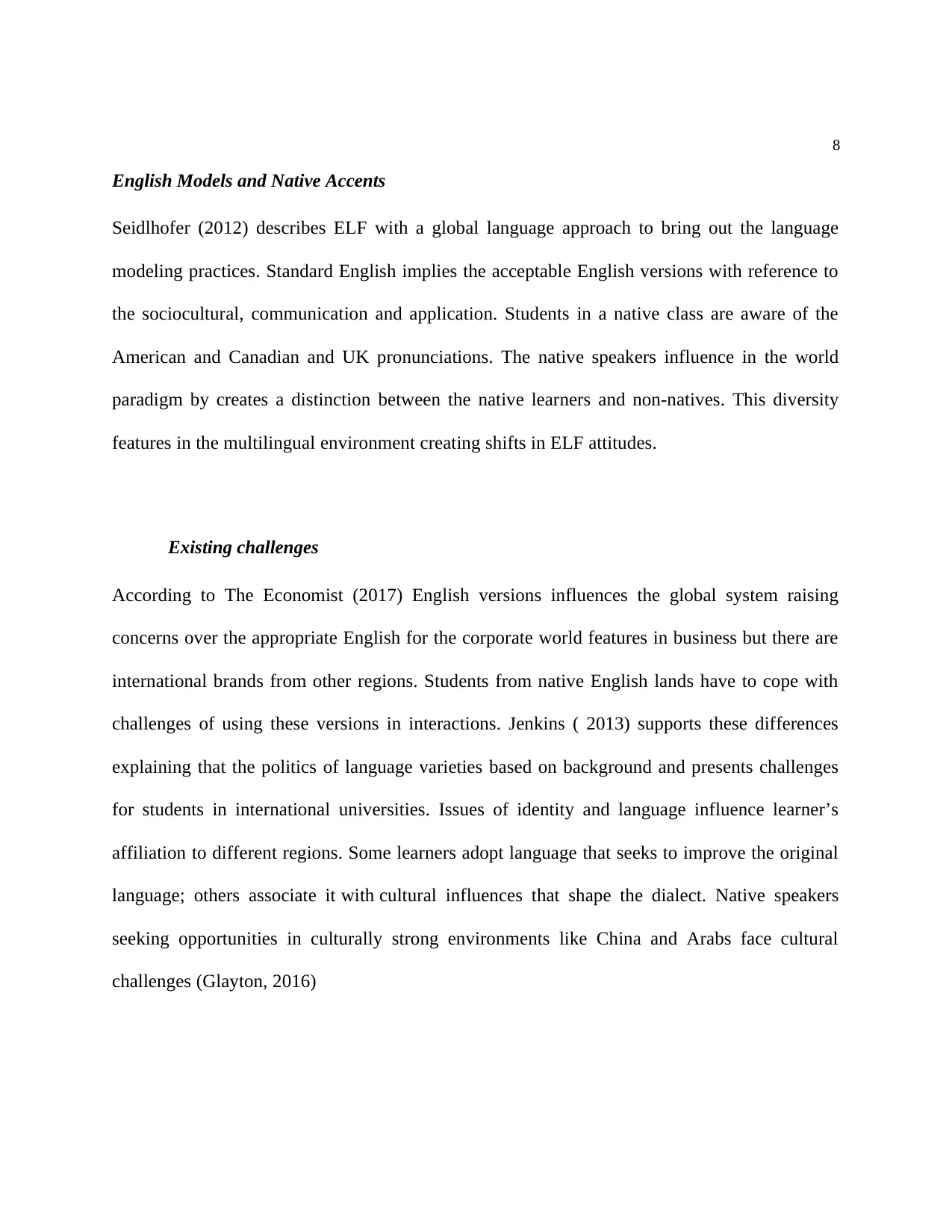
8
English Models and Native Accents
Seidlhofer (2012) describes ELF with a global language approach to bring out the language
modeling practices. Standard English implies the acceptable English versions with reference to
the sociocultural, communication and application. Students in a native class are aware of the
American and Canadian and UK pronunciations. The native speakers influence in the world
paradigm by creates a distinction between the native learners and non-natives. This diversity
features in the multilingual environment creating shifts in ELF attitudes.
Existing challenges
According to The Economist (2017) English versions influences the global system raising
concerns over the appropriate English for the corporate world features in business but there are
international brands from other regions. Students from native English lands have to cope with
challenges of using these versions in interactions. Jenkins ( 2013) supports these differences
explaining that the politics of language varieties based on background and presents challenges
for students in international universities. Issues of identity and language influence learner’s
affiliation to different regions. Some learners adopt language that seeks to improve the original
language; others associate it with cultural influences that shape the dialect. Native speakers
seeking opportunities in culturally strong environments like China and Arabs face cultural
challenges (Glayton, 2016)
English Models and Native Accents
Seidlhofer (2012) describes ELF with a global language approach to bring out the language
modeling practices. Standard English implies the acceptable English versions with reference to
the sociocultural, communication and application. Students in a native class are aware of the
American and Canadian and UK pronunciations. The native speakers influence in the world
paradigm by creates a distinction between the native learners and non-natives. This diversity
features in the multilingual environment creating shifts in ELF attitudes.
Existing challenges
According to The Economist (2017) English versions influences the global system raising
concerns over the appropriate English for the corporate world features in business but there are
international brands from other regions. Students from native English lands have to cope with
challenges of using these versions in interactions. Jenkins ( 2013) supports these differences
explaining that the politics of language varieties based on background and presents challenges
for students in international universities. Issues of identity and language influence learner’s
affiliation to different regions. Some learners adopt language that seeks to improve the original
language; others associate it with cultural influences that shape the dialect. Native speakers
seeking opportunities in culturally strong environments like China and Arabs face cultural
challenges (Glayton, 2016)
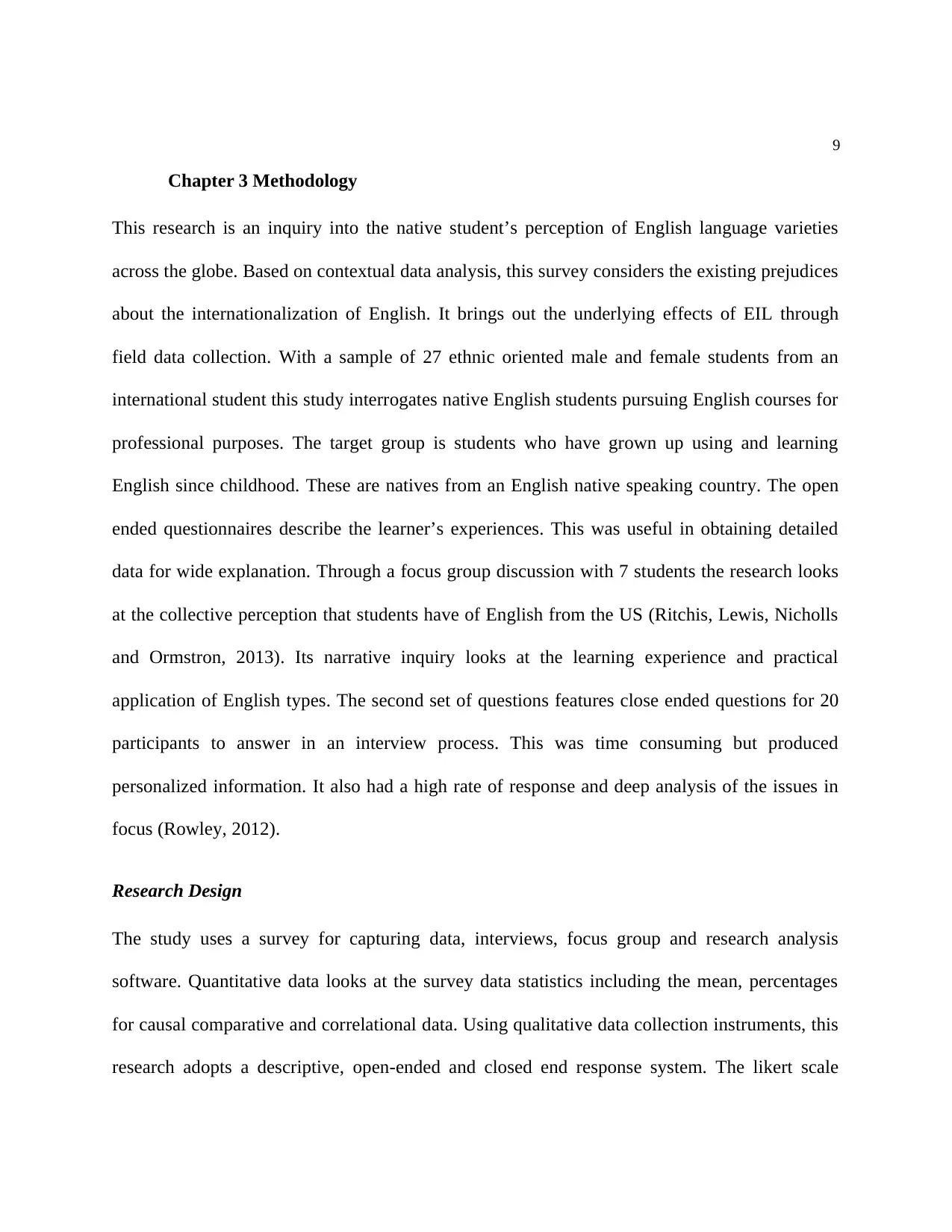
9
Chapter 3 Methodology
This research is an inquiry into the native student’s perception of English language varieties
across the globe. Based on contextual data analysis, this survey considers the existing prejudices
about the internationalization of English. It brings out the underlying effects of EIL through
field data collection. With a sample of 27 ethnic oriented male and female students from an
international student this study interrogates native English students pursuing English courses for
professional purposes. The target group is students who have grown up using and learning
English since childhood. These are natives from an English native speaking country. The open
ended questionnaires describe the learner’s experiences. This was useful in obtaining detailed
data for wide explanation. Through a focus group discussion with 7 students the research looks
at the collective perception that students have of English from the US (Ritchis, Lewis, Nicholls
and Ormstron, 2013). Its narrative inquiry looks at the learning experience and practical
application of English types. The second set of questions features close ended questions for 20
participants to answer in an interview process. This was time consuming but produced
personalized information. It also had a high rate of response and deep analysis of the issues in
focus (Rowley, 2012).
Research Design
The study uses a survey for capturing data, interviews, focus group and research analysis
software. Quantitative data looks at the survey data statistics including the mean, percentages
for causal comparative and correlational data. Using qualitative data collection instruments, this
research adopts a descriptive, open-ended and closed end response system. The likert scale
Chapter 3 Methodology
This research is an inquiry into the native student’s perception of English language varieties
across the globe. Based on contextual data analysis, this survey considers the existing prejudices
about the internationalization of English. It brings out the underlying effects of EIL through
field data collection. With a sample of 27 ethnic oriented male and female students from an
international student this study interrogates native English students pursuing English courses for
professional purposes. The target group is students who have grown up using and learning
English since childhood. These are natives from an English native speaking country. The open
ended questionnaires describe the learner’s experiences. This was useful in obtaining detailed
data for wide explanation. Through a focus group discussion with 7 students the research looks
at the collective perception that students have of English from the US (Ritchis, Lewis, Nicholls
and Ormstron, 2013). Its narrative inquiry looks at the learning experience and practical
application of English types. The second set of questions features close ended questions for 20
participants to answer in an interview process. This was time consuming but produced
personalized information. It also had a high rate of response and deep analysis of the issues in
focus (Rowley, 2012).
Research Design
The study uses a survey for capturing data, interviews, focus group and research analysis
software. Quantitative data looks at the survey data statistics including the mean, percentages
for causal comparative and correlational data. Using qualitative data collection instruments, this
research adopts a descriptive, open-ended and closed end response system. The likert scale
⊘ This is a preview!⊘
Do you want full access?
Subscribe today to unlock all pages.

Trusted by 1+ million students worldwide

10
tackles questions on behavioral response providing information on whether the participants
agree to the statements and the extent to which they do so (Hartley, 2014). This research uses 15
questions (five for the focus group and 10 for individual responses).
Research Instruments
This study uses a questionnaire attached in the Appendix for online data collection. The survey
is on a voluntary basis and the participants undertake an aptitude test, behavioral and cognitive
tests (Abidin, et al., 2012). This experimental research gives insights into English language and
its varieties (Anderson & Shattuck, 2012). SPSS as the analysis tool is ideal for measuring the
variations in male and female participants and analyzing scalar judgments made in tabulated
form (Blunch, 2013). The participants are international students in a foreign learn awaiting
entry into universities in the region. The beginners taking translation and literature classes
include male and female students.
Findings
Students in the UK gain proficiency in English for professional functions. However, many are
ignorant of the effect of standard global English from other regions. Based on historical aspects,
English teachers in the UK apply global learning process and teaching standards with a focus on
the British version. The native respondents showed positivity towards their English version but
some were against the limited use of one version opting for the inclusion of the US English
version. From this analysis, global factors have a great effect on the learner’s perception of the
Standard English language. The respondents seemed to acknowledge the effect that English
tackles questions on behavioral response providing information on whether the participants
agree to the statements and the extent to which they do so (Hartley, 2014). This research uses 15
questions (five for the focus group and 10 for individual responses).
Research Instruments
This study uses a questionnaire attached in the Appendix for online data collection. The survey
is on a voluntary basis and the participants undertake an aptitude test, behavioral and cognitive
tests (Abidin, et al., 2012). This experimental research gives insights into English language and
its varieties (Anderson & Shattuck, 2012). SPSS as the analysis tool is ideal for measuring the
variations in male and female participants and analyzing scalar judgments made in tabulated
form (Blunch, 2013). The participants are international students in a foreign learn awaiting
entry into universities in the region. The beginners taking translation and literature classes
include male and female students.
Findings
Students in the UK gain proficiency in English for professional functions. However, many are
ignorant of the effect of standard global English from other regions. Based on historical aspects,
English teachers in the UK apply global learning process and teaching standards with a focus on
the British version. The native respondents showed positivity towards their English version but
some were against the limited use of one version opting for the inclusion of the US English
version. From this analysis, global factors have a great effect on the learner’s perception of the
Standard English language. The respondents seemed to acknowledge the effect that English
Paraphrase This Document
Need a fresh take? Get an instant paraphrase of this document with our AI Paraphraser
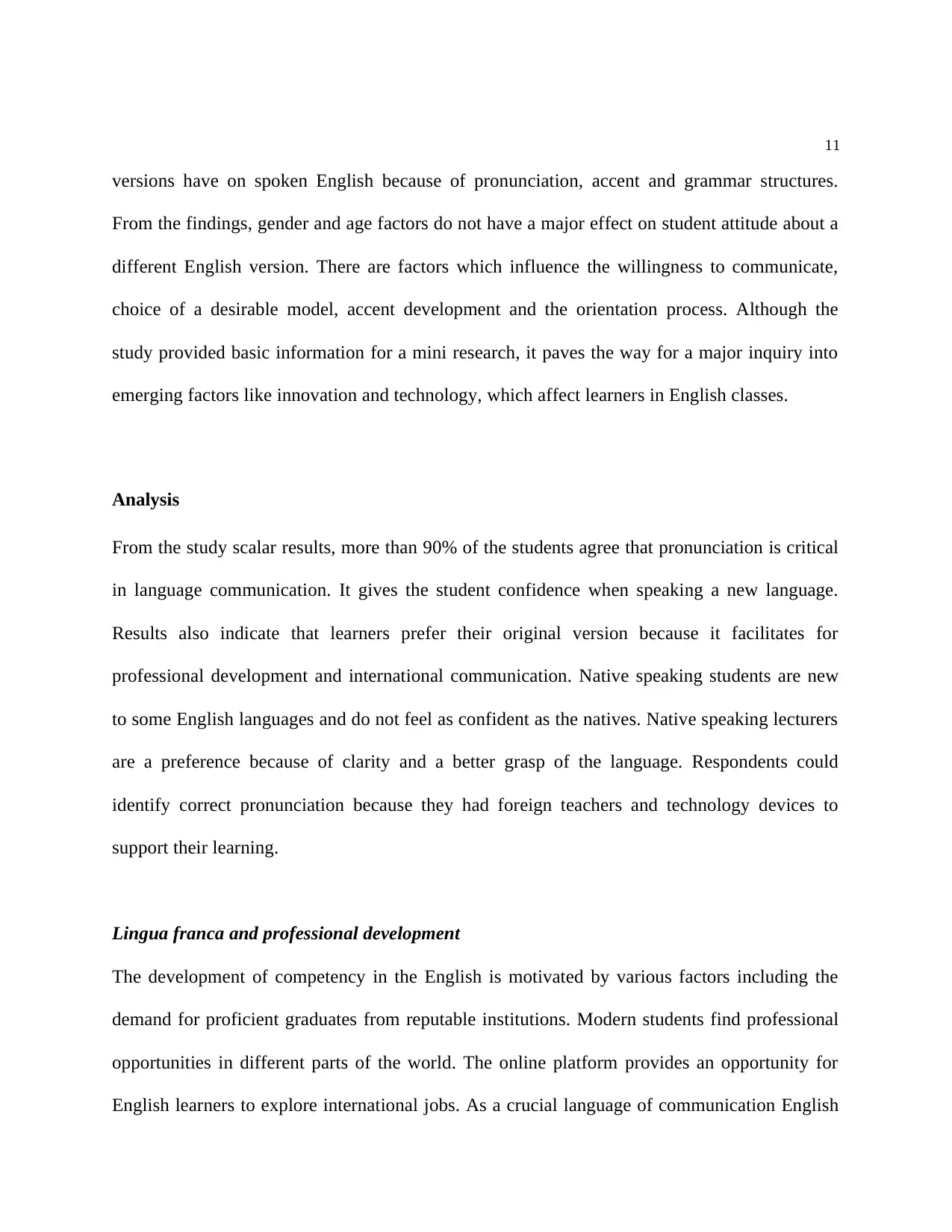
11
versions have on spoken English because of pronunciation, accent and grammar structures.
From the findings, gender and age factors do not have a major effect on student attitude about a
different English version. There are factors which influence the willingness to communicate,
choice of a desirable model, accent development and the orientation process. Although the
study provided basic information for a mini research, it paves the way for a major inquiry into
emerging factors like innovation and technology, which affect learners in English classes.
Analysis
From the study scalar results, more than 90% of the students agree that pronunciation is critical
in language communication. It gives the student confidence when speaking a new language.
Results also indicate that learners prefer their original version because it facilitates for
professional development and international communication. Native speaking students are new
to some English languages and do not feel as confident as the natives. Native speaking lecturers
are a preference because of clarity and a better grasp of the language. Respondents could
identify correct pronunciation because they had foreign teachers and technology devices to
support their learning.
Lingua franca and professional development
The development of competency in the English is motivated by various factors including the
demand for proficient graduates from reputable institutions. Modern students find professional
opportunities in different parts of the world. The online platform provides an opportunity for
English learners to explore international jobs. As a crucial language of communication English
versions have on spoken English because of pronunciation, accent and grammar structures.
From the findings, gender and age factors do not have a major effect on student attitude about a
different English version. There are factors which influence the willingness to communicate,
choice of a desirable model, accent development and the orientation process. Although the
study provided basic information for a mini research, it paves the way for a major inquiry into
emerging factors like innovation and technology, which affect learners in English classes.
Analysis
From the study scalar results, more than 90% of the students agree that pronunciation is critical
in language communication. It gives the student confidence when speaking a new language.
Results also indicate that learners prefer their original version because it facilitates for
professional development and international communication. Native speaking students are new
to some English languages and do not feel as confident as the natives. Native speaking lecturers
are a preference because of clarity and a better grasp of the language. Respondents could
identify correct pronunciation because they had foreign teachers and technology devices to
support their learning.
Lingua franca and professional development
The development of competency in the English is motivated by various factors including the
demand for proficient graduates from reputable institutions. Modern students find professional
opportunities in different parts of the world. The online platform provides an opportunity for
English learners to explore international jobs. As a crucial language of communication English

12
is used in different parts of the globe as an official, business, and academic language. English
from the US dominates the world business market because of the spread of multinationals from
the region. These elements continue to determine the adoption of English standards for
professionals. Language proficiency shapes the language including internal and external
attributes.
Perception
From the findings, 27 respondents were positive about English as a language with varied
translations. 20% strongly disagreed stating that English should have local standard versions.
60% agreed that learners had more confidence relating to others in the global sphere after
training. 70% of the respondents showed a positive attitude towards this diversity
acknowledging that other languages also had dialects. It was obvious that the world is a village
made of different regions hence the variations. However, 6 people identified gaps in knowledge
development noting that studying English was interesting because everyone was communicating
in English online. 80% felt that English variations were interference to the local languages
because business communication like emails was mainly in English.
Language variations
Language variations influence acceptance of English standards among young learners within a
college level age. From the findings students have a challenge coping new English versions in
the business world because of the US accent (Fisher, 2015). Most students also preferred to
sound like the native speakers from the UK because this sounds right. Most learners strongly
agree that they could recognize a native speaker from other parts of the world. As a result, a
is used in different parts of the globe as an official, business, and academic language. English
from the US dominates the world business market because of the spread of multinationals from
the region. These elements continue to determine the adoption of English standards for
professionals. Language proficiency shapes the language including internal and external
attributes.
Perception
From the findings, 27 respondents were positive about English as a language with varied
translations. 20% strongly disagreed stating that English should have local standard versions.
60% agreed that learners had more confidence relating to others in the global sphere after
training. 70% of the respondents showed a positive attitude towards this diversity
acknowledging that other languages also had dialects. It was obvious that the world is a village
made of different regions hence the variations. However, 6 people identified gaps in knowledge
development noting that studying English was interesting because everyone was communicating
in English online. 80% felt that English variations were interference to the local languages
because business communication like emails was mainly in English.
Language variations
Language variations influence acceptance of English standards among young learners within a
college level age. From the findings students have a challenge coping new English versions in
the business world because of the US accent (Fisher, 2015). Most students also preferred to
sound like the native speakers from the UK because this sounds right. Most learners strongly
agree that they could recognize a native speaker from other parts of the world. As a result, a
⊘ This is a preview!⊘
Do you want full access?
Subscribe today to unlock all pages.

Trusted by 1+ million students worldwide
1 out of 22
Related Documents
Your All-in-One AI-Powered Toolkit for Academic Success.
+13062052269
info@desklib.com
Available 24*7 on WhatsApp / Email
![[object Object]](/_next/static/media/star-bottom.7253800d.svg)
Unlock your academic potential
Copyright © 2020–2025 A2Z Services. All Rights Reserved. Developed and managed by ZUCOL.





